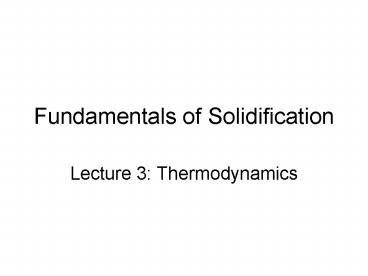Fundamentals of Solidification PowerPoint PPT Presentation
1 / 32
Title: Fundamentals of Solidification
1
Fundamentals of Solidification
- Lecture 3 Thermodynamics
2
Why does liquid solidify at this condition?
3
Why does melting point change with composition?
4
Why does microstructure change with temperature?
5
Why?
6
Why?
7
Outline
- Thermodynamic function of state
- Thermodynamic law
- Computational phase diagram
8
Thermodynamic function of state
- Internal energy
Kinetic energy Potential energy
9
Thermodynamic function of state
- Internal energy, U
- The internal energy of a thermodynamic system is
the total of the kinetic energy due to the motion
of molecules (translational, rotational,
vibrational) and the potential energy associated
with the vibrational and electric energy of atoms
within molecules or crystals. It includes the
energy in all the chemical bonds, and the energy
of the free, conduction electrons in metals. - From Wikipedia
10
Thermodynamic function of state
- Work, W
11
Thermodynamic function of state
- Enthalpy, H
Constant pressure
12
Thermodynamic function of state
- Entropy, S
13
Thermodynamic function of state
- Entropy, S
k1.3806502 ? 10-23 Joule/Kelvin W is the
possibility of arrangement
14
Thermodynamic function of state
- Heat dissipation, Q
15
Thermodynamic function of state
- General free energy
- Gibbs energy constant pressure
- Holmholtz energy constant volume
16
Thermodynamic law
- 2nd law of thermodynamics
- Evolution of system follows a routine of free
energy dropping.
17
Thermodynamic law
solid
Free energy
liquid
melting point
Temperature
18
Thermodynamic law
solid b
solid
Free energy
liquid
melting point
Temperature
19
Thermodynamic law
solid c
solid
Free energy
liquid
melting point
Temperature
20
Thermodynamic law
21
Thermodynamic law
Free energy
Solute composition
22
Computational phase diagram
- Calculation of free energy
- Consider the simple case where everything else
are the same except the atom configurations
23
Computational phase diagram
- Ideal solution
- No repulsive and attractive interactions between
various atoms. - Atoms can mix up ideally
24
Entropy of solution at ideal-mixing
- n atom of A N-n atom B
25
Entropy of solution at ideal-mixing
- Stirling approximation
- Entropy
26
Entropy of solution at ideal-mixing
- Molar entropy of ideal binary solution
- Molar free energy of ideal solution
27
Computational phase diagram
28
Free energy of non-ideal solution
- Interactions between different atoms or molecules
of various components
- Excess mixing energy
?gt0 corresponds to repulsive interaction, such as
Cu-Ag. ?lt0 corresponds to the attractive
interaction, such as Fe-Ni.
29
Free energy of non-ideal solution
30
Free energy of non-ideal solution
31
Free energy of non-ideal solution
32
References
- M.C. Flemings, Solidification processing, 1974.
- A.T. Dinsdale, CALPHAD 15 (1991) 317.
- H.L. Lukas, S.G. Fries and B. Sundman,
Computational Thermodynamics The Calphad Method,
Cambridge University Press, (2007)

